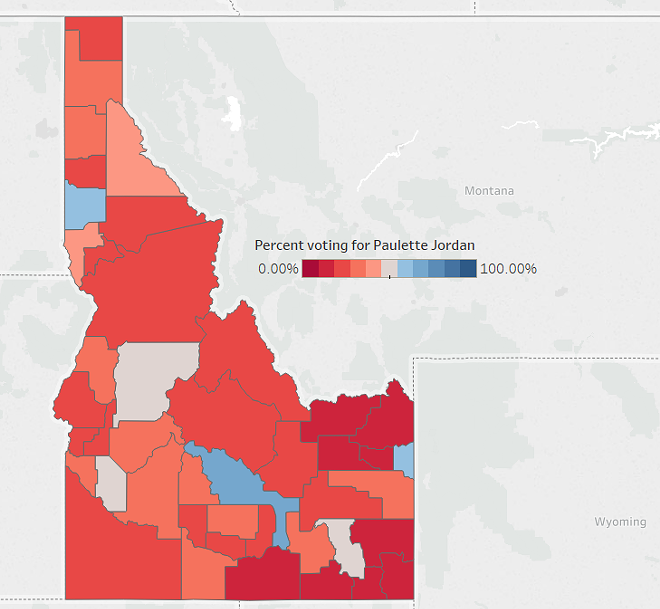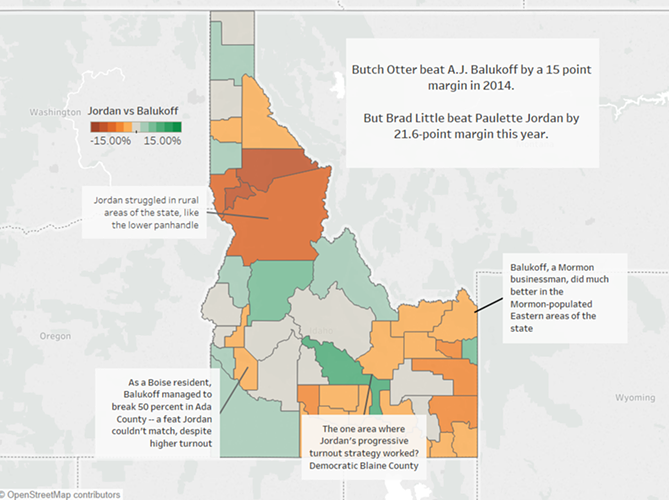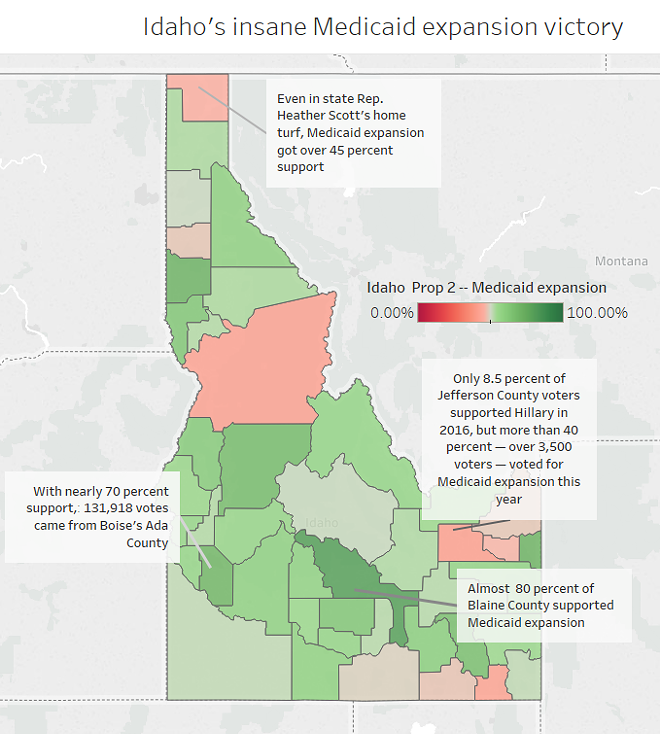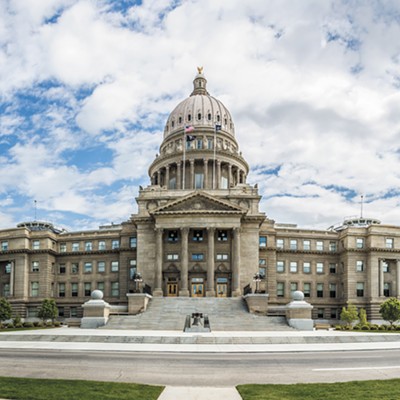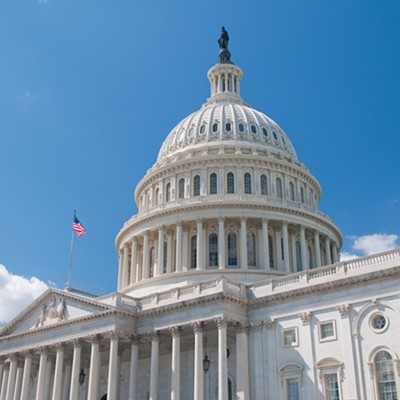The first big national profile came from Anne Helen Petersen at BuzzFeed, titled "Could Paulette Jordan Be the First Native American Governor?"
It was the rumbling that
If Jordan had won the governor's race, all these profiles would have been prophetic. If she had been within 5 points, they would have been laudatory. If she would have been within 10, they may have even been justified.
But Paulette Jordan lost by more than 21 percentage points. She lost by more than 130,000 votes — losing by about 10,000 for each of the national profiles written about her.
The Democratic increase in turnout was dwarfed by the Republican increase in turnout.
In fact, Jordan did significantly worse than her primary opponent, A.J. Balukoff, did back in 2014. He, at least, only lost by a 15 percent margin.
Jordan did even worse than the lieutenant governor candidate Kristin Collum — who at least broke the 40 percent threshold — suggesting voters may have been splitting their ticket, supporting Collum but rejecting Jordan.
Was this the first time a Native American Democrat came so close to becoming Idaho governor?
Not even close: Former Idaho Attorney General Larry EchoHawk did better in 1994, losing by only 5.8 percent.
In fact, as former Gov. Cecil Andrus' Chief of Staff Marc Johnson recalls, EchoHawk got his own share of national profiles back then. In fact, Johnson says, all those national profiles likely hurt EchoHawk.
"It sort of portrayed him as already grasping for something on the national stage, that didn't relate to Idaho," Johnson says. He says EchoHawk got too focused on personality rather than policy, and also stumbled into a bit of a fundraising controversy.
In many ways, Paulette Jordan's downfall was similar, Johnson suggests.
"I think she made a strategic error just in not doing a Beto O’Rourke type campaign," Johnson says. She could have been relentlessly engaged with voters on the ground, he says, constantly holding town hall meetings and creating as much local press as possible.
"That may have given her an opportunity to grow into the role of being a candidate — having to respond to reporters' questions every day," Johnson says. "Good candidates grow into the role, mature their policy positions as the campaign goes along."
Instead, even as Jordan was wowing national outlets, she was feuding with outlets like the Idaho Statesman, objecting to the newspaper's investigative reporting showing that Jordan's campaign manager resigned in part because her campaign had helped create a super PAC to hold political donations from the Coeur d'Alene Tribe.
Johnson argues that, while Jordan raised a ton of money, she misspent a lot of it. In October, he wrote a column pointing out all her strange and wasteful expenditures, including expensive consultants and out-of-state travel.
“It’s a sadly missed opportunity. I thought from the very beginning, I thought she had the kind of profile that could get some traction," Johnson says. "[But] I don’t think she ever provided a rationale for why people should take a look of her for the realistic choice for governor."
Johnson says she was never really able to develop a clear critique of opponent Brad Little as the latest in a long Republican regime.
He suggests Jordan's performance may have even cost Democratic Idaho state Superintendent Cindy Wilson her very narrow race against Sherri Ybarra.
"I expect some of the drag of the top of the ticket didn’t do her any good," Johnson says.
Ultimately, he doubts the national profiles of Jordan helped.
"They probably served as a distraction, to the extent that Idaho voters were paying attention," Johnson says.
In fact, he argues one of the better profiles, in Outside magazine ("Can Paulette Jordan Rise Above Idaho's Partisan Rules?"), could have actually hurt Jordan more had it come out earlier. Her proposal for opening up the Frank Church federal wilderness to logging was pretty out there, Johnson argues.
"[She needed] more stories in the Caribou County Sun and fewer in the Huffington Post," Johnson says.
To be clear, stories about underdogs — even those who don't have a shot in hell are often worth reporting on.
We wrote a ton about the Lisa Brown/Cathy McMorris Rodgers race this year, even though the race, ultimately, wasn't close. But it had looked close enough to be an opportunity to dig into McMorris Rodgers' lengthy record and her role in the Trump administration. By digging into controversies about Lisa Brown, we were able to talk about sex offender policies, college tuition budgeting during the recession and the economy of rural northeastern Washington.
There's some of that in the Paulette Jordan profiles, too: Beyond the "could-she-be-elected" headline (which, to be fair, we've used, too), Petersen's BuzzFeed story has a lot of genuinely good stuff. It showed both why Jordan was a draw, but also why she rubbed a lot of people the wrong way. (Jordan half-disses Lisa Brown in the first few paragraphs.)
Most importantly, it shed light on the state of Idaho's Democratic Party. The story may not have given much insight into how the general election would turn out, but it told you a lot about what would happen in the primary. It showed you that Idaho's Democrats didn't want moderates. They wanted someone they could get excited about.
It's just there aren't that many Democrats in Idaho.
"What they were trying to portray
And in a different state, those kinds of profiles hold up pretty well: Petersen also wrote a ton of coverage for BuzzFeed on Texas Democratic candidate Beto O'Rourke, and plenty of funny conservative Twitter trolls snarked about all the hype. No,
The Beto hype was real.
The worst profiles of Jordan, however, showed little interest in reporting on the very real controversies that Jordan's campaign
Idaho reporters were digging deep into very real questions, like why the hell was Jordan churning through her staff so quickly? Why did she have them sign nondisclosure agreements? Why did other state Democrats seem to dislike her so much? What was the deal with the PAC she helped to set up? What was she doing with all that money?
The Huffington Post, by contrast, was writing
Any concerns were brushed aside with paragraphs like "Jordan has no time for naysayers. She said her critics have long told her she didn’t stand a chance and they’ve been wrong every step of the way."
(The New York Times, at least, actually understood how utterly unlikely it was for Jordan to win: "Idaho Isn’t Turning Blue, but One Democrat Is Turning Heads.")
Here's the thing: There actually was a progressive voting miracle that happened in Idaho on Tuesday night, one full of grassroots activism and characters with passionate personalities.
Arguably, it may have an even greater impact on the Idahoans' lives than electing a Democratic governor.
Two weeks before her Paulette Jordan profile, Anne Helen Petersen wrote another big feature in BuzzFeed: "These Volunteers Are Battling Idaho’s Government To Expand Medicaid."
And indeed, last night, Idaho — conservative, Obamacare-hating, libertarian Idaho — voted overwhelmingly to expand Medicaid, 61 percent to 39 percent. The most impressive showings, in fact, may have come in the counties where the measure lost.
In 2016, only 8.5 percent of Idaho's Jefferson County voted for Hillary Clinton. In 2018, 40 percent of Jefferson County voted to expand Medicaid. It showed that Idaho's legislators were out of sync with what their voters actually wanted, Johnson argues.
"I take my hat off to the folks behind the organizational effort," Johnson says. "They did a terrific job of gathering the signatures and driving home a consistent message in the long haul."
The organizers won bipartisan support, including from outgoing Gov. Butch Otter, while the opposition was comparatively lackluster.
No, in deep red Idaho, voters were not fanatic about Democrat Paulette Jordan. But in deep red Idaho, voters were fanatic about expanding Medicaid.
And that, in and of itself, is a national-profile-worthy story.

